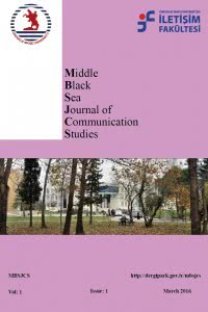Medya Çalışmaları Bağlamında Dönüşen Hikâye Anlatıcılığı: Transmedya Hikâye Anlatısı
İnternet ve teknoloji sistemlerinde yaşanan gelişmeler, markaların durumunu ve tüketicilerin konumunu da değiştirmiştir. Yaşanan bu değişmeler “yeni medya”, “yakınsama kültürü”, katılımcı kültür” gibi birçok kavramı da beraberinde getirmiştir. Bu kavramlara bağlı olarak hikâye anlatısı geleneksel hikâye anlatı yapısından yeni bir anlatı formuna dönüşmüştür. Bu dönüşüm Henry Jenkins’in “transmedya hikâye anlatısı” kavramıyla açıklanmaktadır. Bu çalışmada, 2017 yılında Netflix’de yayınlanan 13 Reasons Why dizisi, transmedya hikâye anlatıcılığı bağlamında ele alınmış ve Henry Jenkins’in belirttiği, transmedya hikâye anlatısında bulunması gereken yedi prensibe göre incelenmiştir. Hikâye anlatıcılığının değişiminin beraberinde ortaya çıkan transmedya hikâye anlatısı merkezde olmak üzere medya çalışmalarında dönüşen hikâye anlatıcılığını tespit etmeye yönelik yapılan bu çalışmada; çağın gereksinimleri ve tüketicinin ihtiyaçları doğrultusunda dijital hikâye anlatımlarının tercih edildiği, transmedya hikâye anlatısının marka/ ürün ve tüketici bağını güncel tutmak için sıklıkla kullanıldığı tespit edilmiştir.
Anahtar Kelimeler:
Transmedya Hikâye Anlatısı, Transmedya, Yakınsama Kültürü, Katılımcı Kültür, Sosyal Medya.
Storytelling Transforming in The Context of Media Studies: Transmedia Storytelling
The developments in the Internet and technology systems have also changed the status of brands and the position of consumers. These changes have brought about many concepts such as “new media”, “convergence culture”, and “participatory culture”. Depending on these concepts, storytelling has transformed from traditional storytelling to a new narrative form. This transformation is explained by Henry Jenkins’ concept of “transmedia storytelling”. In this study, the series 13 Reasons Why, which was broadcast on Netflix in 2017, was considered in the context of transmedia storytelling and examined according to the seven principles that Jenkins described in the transmedia narrative. This study, which aims to determine the transforming storytelling in media studies, puts transmedia storytelling emerging with the change of storytelling in the center. According to the results of the study, digital storytelling is preferred in line with the needs of the era and the needs of the consumer, and transmedia storytelling is often used to keep the brand/ product, and consumer bond up to date has been detected.
Keywords:
Transmedia Storytelling, Transmedia, Convergence Culture, Participant Culture, Social Media,
___
- Atasoy, F. (2007). Kültürler Üzerinde Bilişim Devriminin Etkileri. Modern Türklük Araştırmaları Dergisi, 4(2), 163-178.
- Bolat, N. (2019). Geleneksel Mecralarda Çapraz Medya ve Transmedya Anlatıları Üzerine Bir İnceleme: Ağır Roman Örneği. Selçuk İletişim, 12 (2), 503-531. DOI:10.18094/josc.596244
- Euchner, J. (2016). The medium is the message. Research-Technology Management, 59(5), 9-11. https://doi.org/10.1080/089563082016.1209068
- Gelişken, U. (2017). A’Dan Z’Ye Yeni Nesil Tekniklerle Web Tasarımı ve Web Programlama. Level Kitap.
- Jenkins, H. (2006). Convergence Culture: Where Old and New Media Collide. University Press.
- Jenkins, H. (2009). The Revenge of the Origami Unicorn: Seven Principles of Transmedia Storytelling (Well, Two Actually. Five More on Friday). Henry Jenkins Blog, http://henryjenkins.org/blog/2009/12/the_revenge_ of_the_origami_uni.html, Erişim tarihi: 29.05.2021.
- Jenkins, H. (2010, 21 Haziran). Transmedia Education: the 7 Principles Revisited. Henry Jenkins Blog, http://henryjenkins.org/blog/2010/06/transmedia_education_the_7_pri.html, Erişim tarihi: 29.05.2021.
- Jenkins, H. (2016). Cesur Yeni Medya: Teknolojiler ve Hayran Kültürü. Nihan Yeğengil (çev.). İletişim Yayınları.
- Kogut, B. (2003). Introduction: The internet has borders. B. Kogut içinde, The global internet economy (s. 1-40). The MIT Press.
- Mcluhan, M. (1994). Understanding Media. The MIT Press Cambridge.
- Miller, C.H. (2004). Digital Storytelling: A Creator’s Guide to Interactive Entertainment. Focal Press.
- Nath, K. ve Iswary, R. (2015, April 9-10). What comes after web 3.0? web 4.0 and the future. Proceedings of the International Conference and Communication System (I3CS’15), India, Shillong.
- Strate, L. (2008). Studying media as media: McLuhan and the media ecology approach. MediaTropese Journal, I, 127–142.
- Yanık, A. (2016). Yeni Medya Nedir Ne Değildir? Uluslararası Sosyal Araştırmalar Dergisi, 9(45), 899-910.
- Yıldırım, A. ve Şimşek, H. (2016). Sosyal Bilimlerde Nitel Araştırma Yöntemleri. Seçkin Yayınevi.
- GÖRSEL KAYNAKLAR
- Görsel 1. Müller’in Yeni Medya, Teknoloji ve İnsan İlişkisi Tablosu, https://blog.trendone.com/wp content/uploads/2011/02/TRE-01-11-Speaker-CV-NM-01-2011-RZ.pdf, Erişim tarihi: 19.09.2022.
- Görsel 2. Thirteen Reasons Why isimli web sitesinden bir görüntü, www.thirteenreasonswhy.com/index.html, Erişim tarihi: 01.06.2021.
- Görsel 3. Thirteen Reasons Why isimli yapıma ait Instagram hesabı görüntüsü, https://www.instagram.com/13reasonswhy/ Erişim tarihi: 01.06.2021.
- Görsel 4. Thirteen Reasons Why isimli yapıma ait Facebook hesabı görüntüsü, https://www.facebook.com/13ReasonsWhy/ Erişim tarihi: 01.06.2021.
- Görsel 5. Thirteen Reasons Why isimli yapıma ait Twitter hesabı görüntüsü, https://twitter.com/13reasonswhy Erişim tarihi: 01.06.2021.
- Görsel 6. Dizide yer alan bir karaktere ait açılmış Instagram hesabından bir görüntü, https://www.instagram.com/clayjensen0713/ Erişim tarihi: 01.06.2021.
- Görsel 7. Dizide yer alan bir karaktere ait oluşturulmuş Spotify çalma listesinden bir görüntü, https://open.spotify.com/playlist/3o1j1ubf74DJKdRhBEflyL Erişim tarihi: 01.06.2021.
- Yayın Aralığı: Yılda 2 Sayı
- Başlangıç: 2016
- Yayıncı: Ondokuz Mayıs Üniversitesi
Sayıdaki Diğer Makaleler
Televizyon Yayıncılığında Dijitalleşme ile Değişen Yayıncılık
Hilal Gamze ÇAKIR, Nursel BOLAT
12 Mart 1971 Muhtırası'nın Dönemin Köşe Yazılarına Yansımaları
Medya Çalışmaları Bağlamında Dönüşen Hikâye Anlatıcılığı: Transmedya Hikâye Anlatısı
Kişisel ve Bağımsız Film Yapımı: Amerika Amerika
